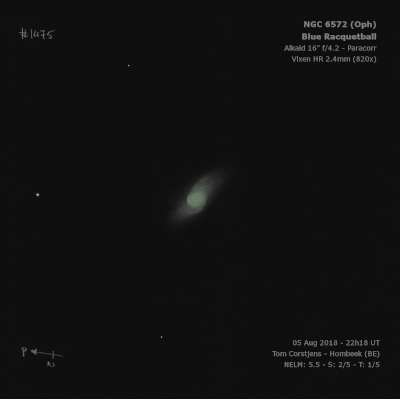
Wilhelm Struve discovered NGC 6572 = ∑ 6 = h2000 on 18 Jul 1825 with the 9.6" Fraunhofer refractor at the Dorpat Observatory. It was included in his list of 9 "Nebulae detectae" in an appendix to his main catalogue of double stars, which was published in 1827. According to Wolfgang Steinicke, Bessel earlier measured NGC 6572 in 1822 during his "Zone observations" at Konigsberg, but didn't mention it as being nebulous.
John Herschel first observed this planetary on 9 May 1828 and recorded "a beautiful round, perfectly well defined and brilliant disc, equally a star 8-9 mag. White equably bright. Well seen in broad morning twilight. A * 9-10m follows, 2' dist. The sweeping power shows it as a * of large diameter, which could not escape examination in a good night; with 240 the disc seen as described. It cannot be more than 4" diameter." On 19 Aug 1830, JH showed the planetary to Wilhelm Struve at Slough. Auwers made several measurements of the size, including 6.4"x5.3", and Secchi (1856) measured it at 7.5"x7.2" and noted a brighter center. At Birr Castle, the color was described as "very blue".
Based on Crossley photographs at Lick, Curtis (1918) reported NGC 6572 as "an oval disk, fading out slightly towards edges, 14"x9" in a 5 min exposure and 16"x13" in the long exposure. No structural details visible."
200/250mm - 8" (7/79): bright, small, very high surface brightness.
300/350mm - 13.1" (8/24/84): very bright, small, about 15" diameter, slightly elongated N-S, extremely high surface brightness, blue color. Very faint outer halo is elongated N-S. No central star seen.
400/500mm - 17.5" (6/3/00): at 220x appears as a very bright, small, intense blue oval, ~15"x12". At 280x-500x, a thin outer envelope is obvious with the inner oval a uniform high surface brightness. No central star visible.
600/800mm - 24" (9/1/16): at 200x, 375x and 500x; extremely high surface brightness, saturated blue-green disc slightly elongated oval N-S, perhaps 14"x10". A very thin shell appears to encase the disc and occasionally an extremely low surface brightness outer halo appears to extend mostly north and south.
900/1200mm - 48" (4/4/11): I only took a quick look at this colorful planetary in the 48-inch at the end of the last night when the seeing the poor, but I could tell the very high surface brightness blue/green component was surrounded by much fainter outer halo that appeared slightly pinkish!
Notes by Steve Gottlieb